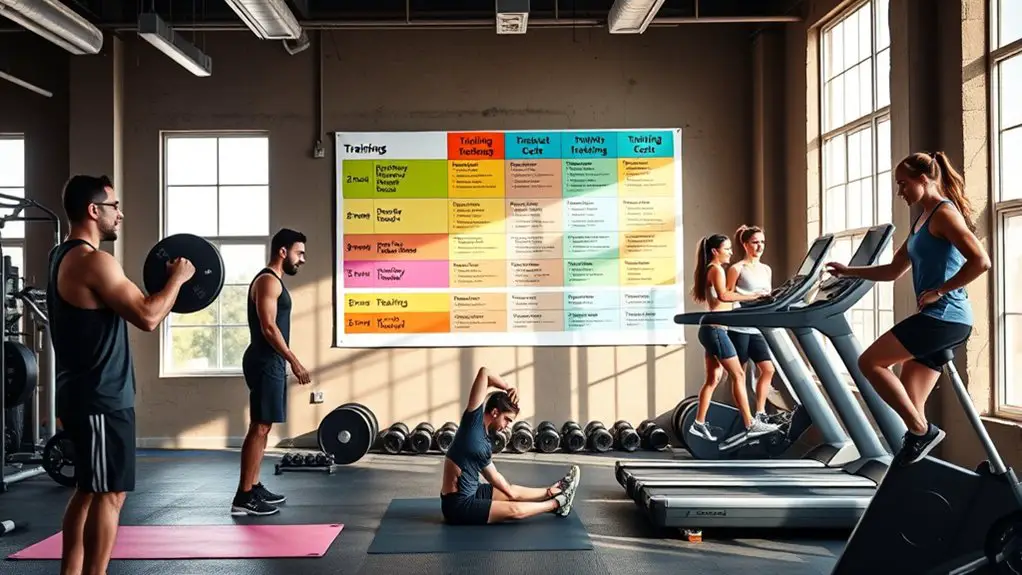How to Implement Periodization in Your Workout Routine

To implement periodization in your workout routine, start by defining your fitness goals, whether it’s weight loss or muscle gain. Create a structured plan with phases like macrocycle, mesocycle, and microcycle, incorporating progressive overload and recovery periods. Track your progress using performance metrics to make adjustments as needed. Remember to listen to your body and consult fitness professionals for guidance. Stick around to discover more about avoiding common periodization mistakes and enhancing your training effectiveness.
Understanding the Basics of Periodization

When you’re looking to optimize your workout routine, understanding the basics of periodization is key. Periodization principles involve systematically varying your training intensity and volume over time to prevent plateaus and reduce injury risk. By structuring your workouts into distinct phases, you can enhance performance while ensuring adequate recovery.
Start by identifying your fitness goals, whether it’s building strength, improving endurance, or enhancing overall fitness. Then, establish cycles that alternate between high-intensity and low-intensity training. This approach not only keeps your body challenged but also allows for necessary rest periods, which are essential for long-term safety and efficiency.
Keep in mind that listening to your body is essential. If you’re feeling fatigued or sore, it’s okay to adjust your training intensity. Incorporating periodization into your routine can help you achieve your goals safely while minimizing the risk of overtraining.
Different Types of Periodization Models
When it comes to periodization, you’ve got a few models to choose from. Linear periodization focuses on gradually increasing intensity, while undulating periodization offers more variation in your workouts. Understanding these differences can help you tailor your training for peak results.
Linear Periodization Explained
Linear periodization is a structured approach to training that gradually increases intensity over time, allowing you to build strength and endurance effectively. Typically, this model involves a progression where you start with lighter weights and higher repetitions, then shift to heavier weights and lower repetitions. This linear progression helps guarantee that you’re safely adapting to the increased demands on your body, minimizing the risk of injury. By focusing on steady, incremental increases, you can achieve significant strength gains without overtraining. It’s crucial to listen to your body throughout this process and make adjustments as needed. Remember, consistency and patience are key to reaping the benefits of linear periodization in your workout routine.
Undulating Periodization Benefits
While many athletes find success with linear periodization, undulating periodization offers a dynamic alternative that can enhance training efficiency and results. This method adjusts your workout intensity frequently, allowing for varied stimulus and minimizing burnout. You’ll experience improved recovery benefits as your body adapts to the changing demands.
| Day | Workout Type | Intensity Level |
|---|---|---|
| 1 | Strength Training | High (80-90% RM) |
| 2 | Hypertrophy | Moderate (70-80% RM) |
| 3 | Endurance | Low (60-70% RM) |
Assessing Your Fitness Goals

How can you effectively determine your fitness goals? Start by reflecting on what you want to achieve, whether it’s weight loss, muscle gain, or improving endurance. Be specific in your goal setting; vague goals can lead to frustration. Next, consider your current fitness level and any potential limitations to guarantee your goals are realistic and safe. Use performance metrics, like measuring your strength or endurance, to establish a baseline. This data not only helps you track progress but also informs your goal-setting process.
Designing Your Periodized Workout Plan
Once you’ve set clear and attainable fitness goals, it’s time to design a periodized workout plan that aligns with those objectives. Start by incorporating different periodization techniques, like linear or undulating periodization, to guarantee your workouts progress safely over time.
Next, create workout variations to prevent plateaus and keep your routine engaging. For instance, alternate between strength training, endurance workouts, and flexibility sessions throughout your plan. This not only enhances your performance but also reduces the risk of injury.
Be certain to schedule specific phases for each type of training, allowing time for recovery and adaptation. During each phase, gradually increase the intensity or volume to challenge your body while prioritizing safety. Remember, it’s essential to listen to your body and adjust as needed. Following these steps will help you build a balanced and effective periodized workout plan tailored to your goals.
Tracking Progress and Making Adjustments

To guarantee your periodized workout plan is effective, tracking your progress and making timely adjustments is vital. Start by establishing clear progress metrics, such as weight lifted, repetitions, and workout duration. Regularly recording these metrics helps you visualize your improvements and identify any plateaus.
If you notice stagnation, consider implementing adjustment strategies. This might mean increasing weights, altering your rep range, or changing your exercise selection to target different muscle groups. Be mindful of how your body responds to these changes—if you feel fatigued or experience discomfort, it may be a sign to dial back.
It’s important to listen to your body and maintain safety while pushing your limits. Regular assessments every few weeks can guide your adjustments, keeping your routine aligned with your goals. By staying attentive and flexible, you’ll maximize the effectiveness of your periodized workout plan.
Common Mistakes to Avoid in Periodization
When you’re implementing periodization, it’s easy to overlook some key elements that can derail your progress. Ignoring recovery phases, being inconsistent with training loads, and neglecting specific goals can lead to setbacks. Let’s explore these common mistakes so you can maximize your results.
Ignoring Recovery Phases
While many people focus on the intensity and volume of their workouts, overlooking recovery phases can sabotage progress and lead to burnout. Ignoring the recovery significance in your training can increase the risk of injury and hinder your overall performance. It’s crucial to incorporate effective recovery strategies, such as active rest days, proper nutrition, and sufficient sleep, to allow your body to heal and adapt. Without these critical recovery periods, you may find yourself feeling fatigued and unmotivated. Remember, recovery isn’t a sign of weakness; it’s a vital component of a successful workout routine. Prioritizing recovery will help you achieve your fitness goals safely and sustainably, ensuring that you stay on track without sacrificing your well-being.
Inconsistent Training Loads
Inconsistent training loads can severely undermine the effectiveness of your periodization strategy, leading to suboptimal gains and increased risk of injury. When you vary your weights and intensity too frequently, you’re likely to experience inconsistent progress, making it hard to track improvements. This unpredictability can also result in fluctuating motivation, as you might feel discouraged if you’re not seeing the results you expect. To maintain a steady path toward your goals, aim for a structured approach to loading. Stick to your planned progression and avoid the temptation to overexert yourself or underperform. Remember, consistency is key; it promotes safety and helps you build strength effectively over time, ensuring your periodization plan works as intended.
Neglecting Specific Goals
Neglecting specific goals can derail your periodization efforts, making it difficult to achieve the results you desire. Without clear goal prioritization, you might end up spreading yourself too thin, trying to improve multiple areas at once. This lack of focus can lead to safety issues, as your body may not be adequately prepared for the demands placed on it. Training specificity is vital; it guarantees that your workouts are tailored to meet your individual objectives. By identifying and prioritizing your goals, you can create a more effective and safer training plan. Remember, a well-structured periodization approach that emphasizes specific goals will ultimately enhance your performance while minimizing the risk of injury. Focus on what matters most for your progress.
Frequently Asked Questions
How Long Should Each Training Phase Last?
When considering training duration, it’s essential to think about how long each phase should last. Generally, you’ll want each phase structure to be about 3 to 6 weeks, depending on your goals and fitness level. This allows your body to adapt without risking injury. Remember, it’s vital to listen to your body and adjust the duration if you feel fatigued or need more recovery time. Prioritize safety in your training!
Can Beginners Use Periodization Effectively?
Yes, beginners can use periodization effectively, but there are some misconceptions. Many think it’s only for advanced athletes, but it’s about training consistency and gradual progression. By structuring your workouts, you can safely balance intensity and recovery, minimizing the risk of injury. Start with simple cycles, focusing on basic movements. As you gain experience, you’ll find periodization helps you improve steadily, building a solid foundation for long-term success.
What Equipment Is Needed for Periodized Training?
For effective periodized training, you’ll need basic equipment like dumbbells, barbells, and resistance bands for strength training. Additionally, a bench and a sturdy mat can enhance your workouts while ensuring safety. Don’t forget to incorporate tools for recovery strategies, such as foam rollers or massage balls, which help prevent injury and promote muscle recovery. Always prioritize safety by using proper form and adjusting weights according to your fitness level.
How Do I Know When to Change Phases?
How do you know when it’s time to switch things up? Pay attention to phase indicators, like plateaus in progress or increased fatigue. If you’re not feeling challenged anymore, your body’s likely reached a training adaptation. It’s essential to avoid injury, so consider changing phases every 4 to 6 weeks or when you notice declining performance. Regularly evaluating your workouts helps guarantee you stay safe and keep making gains.
Is Periodization Beneficial for Endurance Athletes?
Yes, periodization’s definitely beneficial for endurance athletes. It helps you maximize performance improvement by structuring your training in phases, allowing for specific focus on different aspects of endurance. This approach promotes effective training adaptations and reduces the risk of injury from overtraining. By varying intensity and volume, you can guarantee that your body gets the recovery it needs, while still pushing towards your goals. Just remember to listen to your body throughout the process!





